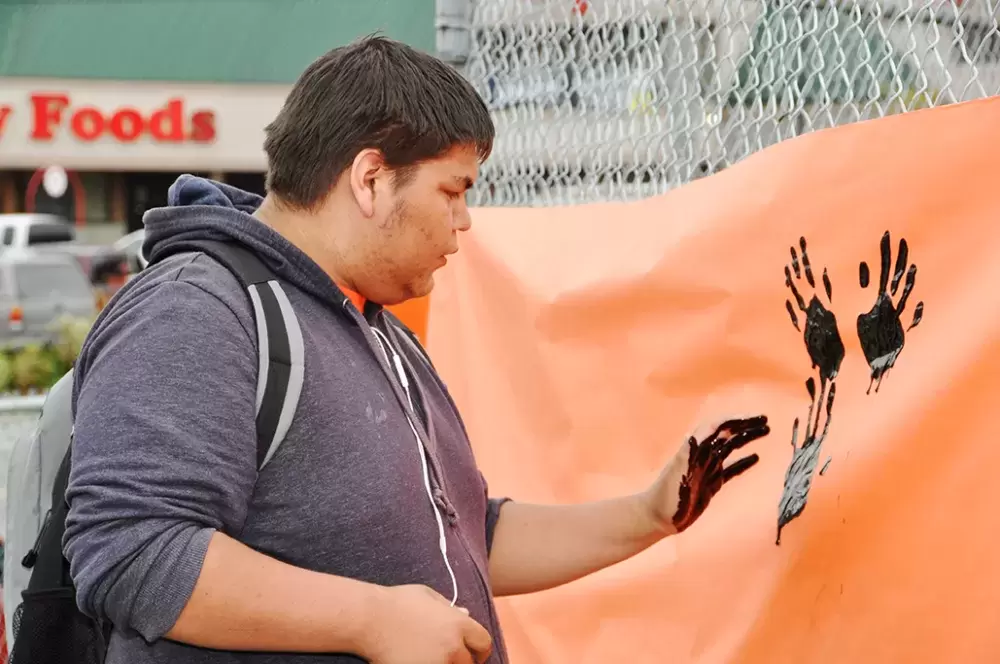Students at Vast had a chance to learn about the history and the legacy of Canada’s Indian residential school system on Orange Shirt Day.
Nuu-chah-nulth Education Worker Richard Samuel said the event, which took place in the morning of Sept. 30, was put together in consultation with the Vast Aboriginal Team.
“The idea is to promote the healing side of the Indian residential school experience,” Samuel said. “That is what this day represents.”
Samuel said all Alberni schools had Orange Shirt events lined up, to teach students about this part of Canadian history.
Orange Shirt Day, now celebrated Canada-wide, was inspired by the experience of Stswecem'c Xgat'tem First Nation member Phyllis Jack Webstad, who had her brand-new orange shirt ripped off her back the day she entered the residential school in Mission in 1973.
Students at the former Eighth Avenue School campus first viewed a series of short videos, the first featuring Jack Webstad, and were invited to create a piece of visual art on cedar tiles, to become part of an assembled display.
Pointing out 10 tiles that had been previously completed, Samuel said the official plan was to send them off for a large, centralized project.
“Then I thought, ‘Why send it away? We can keep it here, as a continuing piece of learning’.”
The event took place in the Vast cafeteria, where some students availed themselves of a pancake breakfast.
“Today we are going to learn a little bit about Indian residential schools,” Samuel began. He later warned that some of the material they were going to hear was “very harsh.”
Samuel gave a brief history of the residential school system, including Alberni Indian Residential School and the Christie School on the West Coast. He noted that in the schools, siblings were deliberately kept separate.
“That is the disconnect that survivors feel today, and it still hurts them…”
In the first video, Phyllis Jack Webstad described her experience as a third-generation residential school student, and her determination to re-connect with the culture she had stripped away.
Webstad was followed by “Shi-Shi-Etko,” which was a dreamlike re-telling of a young girl’s final few days with her family.
Shi-Shi-Etko bathes in the creek with her mother, learns about traditional foods from her grandmother. She vows, “I will remember everything.”
The girl then places a flower at the base of a tree, saying, “Dear Creator: please keep my Grandmother Tree safe and my memories intact.”
The video ends with Shi-Shi Etko being hauled off to residential school with two other children in the bed of an old 1950s pickup truck.
Samuel pointed out the interactions between the child, her parents and grandparents.
“That is how traditions were passed down,” he said. “Parents didn’t understand why their children were being taken away.”
The final video was “100 Years of Loss,” featuring a sequence of interview clips with survivors. Part recollection, part chronology of the forced assimilation system designed, as described by long-time Deputy Superintendent of Indian Affairs Duncan Campbell Scott, “to kill the Indian in the child.”
One female survivor vividly illustrated the insanity of that process. At breakfast time on her seventh birthday, she was made to sit at attention while her classmates sang “Happy Birthday” in English.
In almost any other context, it would have been a happy occasion, but, as she recalls, she was horrified.
“To a young child, residential school did not make much sense,” she said. The result was predictable and consistent: “Emotionally, we shut down.”
100 Years of Loss concluded with cautious optimism on the part of the survivors. But survivors must be willing to share their experience and to stay engaged, in order to fight the multi-generational legacy of the schools.
“They were physically and verbally assaulted while attending residential schools,”’ Samuel said. “That’s what they knew; that’s what they learned. So they had problems with their children and their grandchildren. But now, survivors talk about how they are prepared to take on that healing, both for themselves and for their families.”
Samuel introduced Project of Heart, which honours and remembers survivors, which introduced the cedar tile art theme. Fellow Aboriginal Team teacher Kama Money invited the students to create their own tiles, using a variety of paints, pens and markers.
“Simple is good,” she noted.
Hesquiaht member Kwa-sah George, 17, said he would have to think about what to draw on his tile. Thinking about the presentations, George said he appreciated the Vast program, which is less regimented than the mainstream school system, and a world away from the residential school system.
“I was sick quite a bit in my elementary and middle school years. By the time I got to high school, it was way too hard,” he said.
Ahousaht member James Frank, also 17, said he also had a difficult time adjusting to the regular high school.
“I grew up in a lot of different places,” he said, naming a string of small and large communities across Vancouver Island. “This is my second year here.”
Frank said he appreciates the less-structured learning environment, and he is still thinking about where he plans to continue his education.
Matthew Gilges displayed the two-tile set he has already created, depicting Night & Day. It reflects his feelings on life, he said.
“There is always hope, even if it’s the darkest side,” he said.
Gilges, who was born in Alberta, said he does not have any official aboriginal heritage – but he is working on it. He explained that his father, who passed away when he was only a few months old, was believed to have an aboriginal ancestor.
“I need to confirm it. That means I will have to go through all the records going all the way back,” he said. “I want to know.”
To cap off the event, students and staff were invited to stamp a handprint on a wide orange mural strung along the fenceline on 10th Avenue, opposite Quality Foods. Dipping their hands in thick black paint, participants made their indelible mark, while passing motorists honked their support.







